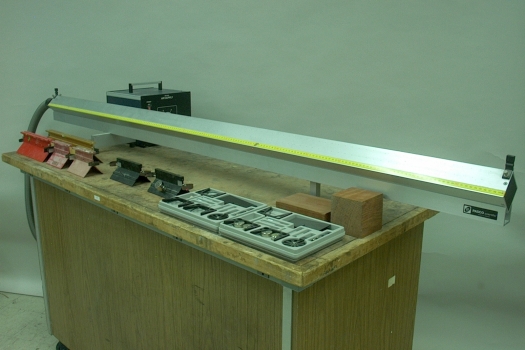 |
 |
 |
 |
A video of this demonstration is available at this link.
The Ealing air track at left is 3.8 meters long. Though it is possible to use it in both lecture halls 1610 and 1640, in 1640 the smaller PASCO unit at right, which is 2 m long, is probably more convenient.
By sending one of these air track carts into another, you can illustrate elastic and inelastic collisions in one dimension. The masses of the first three carts (from the left, in the photograph at left above) are in the ratios of 3:2:1. (All carts of similar length, of course, have similar mass.) Some carts have a spring at either end, which allows you to cause an elastic collision by sending one at a second cart. The medium-length cart (2m) and two short carts (m) have a Velcro® strip at one end, so that you can cause the two short carts, or the medium-length cart and one short cart, to undergo an inelastic collision. (The medium length cart has the Velcro® hooks, so you must make sure to use it with the short cart that has the loops.) The two carts at the right have magnets, so that you can show either elastic or inelastic collisions with them. If you use the smaller track shown at right, the gliders have springs at either end, one of which you can substitute with either a needle attachment, or an attachment that has a wax plug (to receive the needle), for performing inelastic collsions. The carts have a mass of 190 g (each), and you can add 50-g slugs to them in pairs, to make masses of either 290 or 390 g. Though the Ealing gliders overlap the scale along the bottom edge of the PASCO air track, the air cushion raises them sufficiently that this does not interfere with their operation, and, should you desire, you can use those gliders on the smaller air track.
This apparatus allows you to illustrate in a rather graphic way the principle of conservation of linear momentum, and also two special classes of collisions – those in which kinetic energy is conserved (elastic), and those in which kinetic energy is not conserved (inelastic). In both types of collision, of course, momentum is always conserved, as is total energy.
First, we consider an elastic collision. In this case, the air track carts separate immediately after collision, which occurs in a very short time. If we have two carts, their total momentum before and after collision is m1v1i + m2v2i = m1v1f + m2v2f, where the subscripts 1 and 2 refer to the two carts, and i and f refer to velocity before collision and after collision, respectively. Since kinetic energy is conserved in an elastic collision, we also have (1/2)m1v1i2 + (1/2)m2v2i2 = (1/2)m1v1f2 + (1/2)m2v2f2. We can rewrite these equations as m1(v1i - v1f) = m2(v2f - v2i), and m1(v1i2 - v1f2) = m2(v2f2 - v2i2). Assuming that the initial and final velocities for each cart are not equal, if we divide the second equation by the first, we have v1i + v1f = v2f + v2i, or v1i - v2i = v2f - v1f. We see that in this type of collision, the relative velocity of the two carts after collision equals the opposite of their relative velocity before collision.
From the last equation(s), we can get expressions for the final velocities, v1f = v2f + v2i - v1i, and v2f = v1i + v1f - v2i. Inserting these into the momentum equation above gives: v1f = [(m1 - m2)/(m1 + m2)]v1i + [2m2/(m1 + m2)]v2i, and v2f = [2m1/(m1 + m2)]v1i + [(m2 - m1)/(m1 + m2)]v2i.
These equations indicate that there are several interesting special cases. First, if both carts have equal mass, one term in each equation disappears, and the other equals 1, giving v1f = v2i, and v2f = v1i. Thus, the two carts exchange momentum, each going off with the velocity that the other had had before the collision.
Next, we examine what happens when one of the carts is initially at rest, say m2. Now, v2i = 0, and v1f = [(m1 - m2)/(m1 + m2)]v1i, and v2f = [2m1/(m1 + m2)]v1i. If the two carts have the same mass, we have v1f = 0, and v2f = v1i. Thus, after collision, the first cart stops while the second one takes off with the velocity that the first one had had before collision.
If the stationary cart is much heavier than the first, so m2 ≫ m1, then we have v1f ≈ -v1i, and v2f ≈ 0. So if a light object collides with a much heavier stationary object, the light object rebounds with the opposite velocity to its initial velocity, while the heavier object remains at rest.
If the moving cart is much heavier than the stationary cart, then v1f ≈ v1i, and v2f ≈ 2v1i. So the incoming cart, after collision, keeps moving with essentially its original velocity, while the lighter cart leaves with approximately twice the velocity of the heavier cart.
Now we consider a perfectly inelastic collision, in which the two carts stick together after collision. This means that the carts have a common final velocity, and m1v1i + m2v2i = (m1 + m2)vf. If one cart is initially at rest, say m2, then we have m1v1i = (m1 + m2)vf, and vf = m1v1i/(m1 + m2). If the two initial momenta are equal and opposite, they exactly cancel, and vf = 0. That is, on collision the carts stick together and stay at rest. An obvious example of this is two carts of equal mass heading towards each other with the same speed.
In such a collision, kinetic energy is lost, either in deformation of the colliding objects, heat or both.
References
1) Resnick, Robert and Halliday, David. Physics, Part One, Third Edition (New York: John Wiley and Sons, 1977), pp. 190-193.